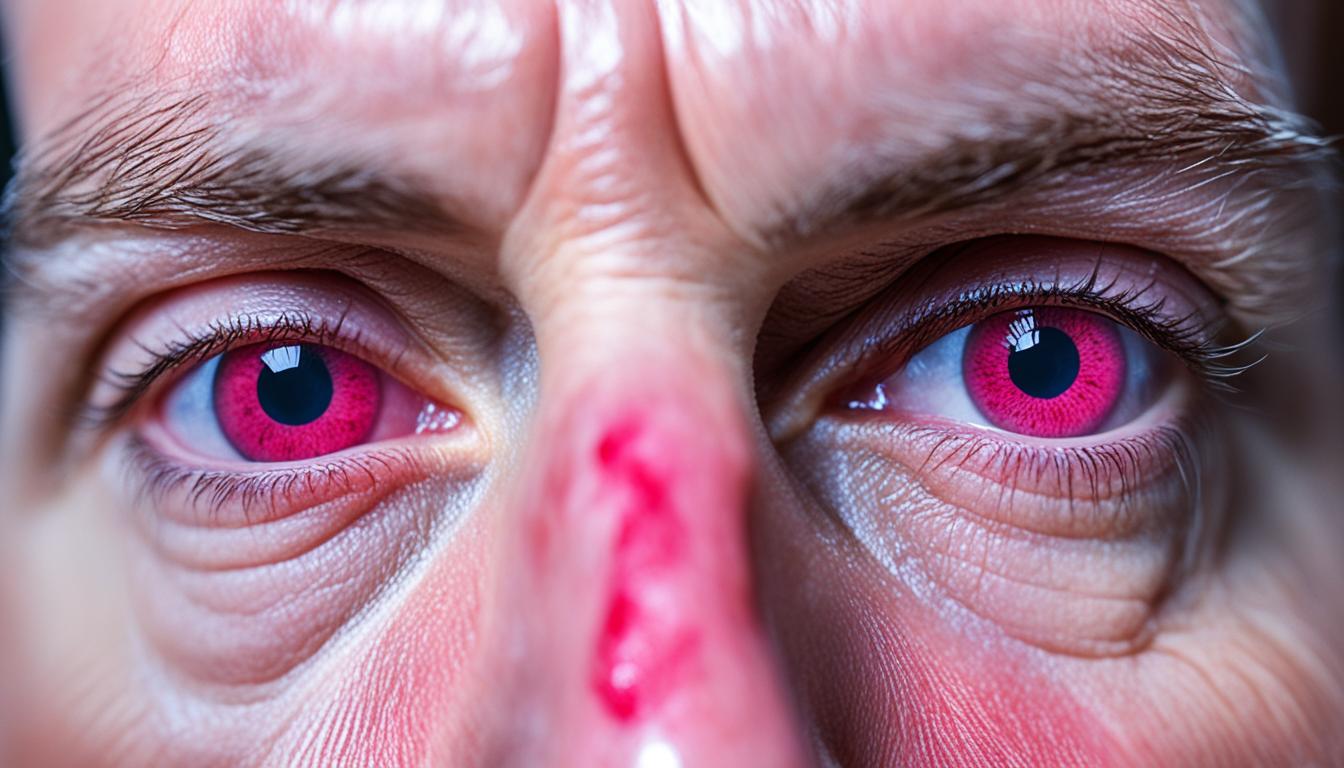Pink eye is also known as conjunctivitis. Many things can cause this eye disease like infections or allergic reactions. It’s marked by red or pink eyes, eye discharge, and a pink hue. This may also cause excess tears, light sensitivity, eye pain, and blurry vision.
It’s important to get diagnosed and treated quickly to avoid complications. Stem cell therapy is a new treatment for pink eye. It aims to heal the eyes faster by replacing damaged tissues.
Key Takeaways:
- Pink eye, or conjunctivitis, is a common eye disease characterized by inflammation of the conjunctiva.
- Causes of pink eye can include bacterial or viral infections, as well as allergic reactions.
- Common symptoms of pink eye include redness, discharge, tearing, light sensitivity, discomfort, and blurry vision.
- Prompt diagnosis and appropriate treatment are crucial for preventing complications and promoting healing.
- Stem cell therapy has emerged as a potential treatment option for pink eye, offering the potential for tissue regeneration and faster healing.
Causes of Pink Eye: Bacterial, Viral, and Allergic
Pink eye, or conjunctivitis, has different kinds like bacterial, viral, and allergic. Knowing what caused it helps doctors treat it right. This makes dealing with pink eye easier.
Bacterial Conjunctivitis
Bacterial conjunctivitis comes from bacteria like Staphylococcus aureus. It spreads when you touch something infected, or from person to person. Not washing hands before touching your eyes can make it spread.
The main sign is a thick yellow discharge making your eyelids stick together. You might have red eyes, feel itchy, or like something’s in your eye.
Viral Conjunctivitis
Viral conjunctivitis is from viruses like adenoviruses, linked to the common cold. It’s very contagious and spreads easily. This happens through breathing in droplets from an infected person or touching something they touched.
Instead of a thick discharge, your eyes will be watery and itchy. They can get red, swell, and feel sensitive to light. It begins in one eye but can move to the other soon.
Allergic Conjunctivitis
Allergic conjunctivitis results from the immune system reacting to pollen, pet dander, or chemicals. It’s not catching but happens when you’re around things you’re allergic to.
It makes your eyes red, watery, and very itchy. You might want to rub them a lot. You could also have other allergy signs like sneezing, a runny nose, or throat irritation.
It’s crucial to find out what kind of pink eye it is to treat it correctly. If you think you or someone you know has pink eye, see a doctor. They can give you the best plan for treatment.
Transmission and Symptoms of Pink Eye
Pink eye, or conjunctivitis, spreads in several ways. It is often caught by touching infected surfaces or through direct contact. The disease can also spread through eye secretions. Being near someone with a viral infection can lead to pink eye as well. It’s seen a lot in kids. This is because they are still learning about keeping things clean. But, grown-ups who work or live with kids can also get it.
Spotting pink eye early is key to stop its spread and get treatment. Signs include the eyes turning red or pink, eye gunk, lots of tears, not liking bright light, eye pain, and seeing things blurry. These signs can change based on what’s causing the pink eye.
People who wear contact lenses should be careful. If you think you have pink eye, take your lenses out right away. Then, go see a doctor fast. Contact lens wearers can have more serious issues with pink eye if it’s not treated quickly.
Doctors can often tell if it’s viral or bacterial pink eye by looking at the symptoms. Bacterial pink eye might have thick, yellow gunk. But viral pink eye often makes your eyes water and itch. Still, only an eye doctor can say for sure. They check your eyes and decide how to treat it best.
Remember, pink eye might not always be an infection. Other eye problems can look like pink eye. Talking to an eye doctor is the best way to figure out what’s really going on. They can find the right treatment for you.
With the right care, most pink eye cases get better in ten to fourteen days. But the signs can go away sooner or last longer, based on why you’re sick and other things. Getting advice from a doctor is always a good idea. They can help you feel better and make sure you don’t spread pink eye to others.
Conclusion
Pink eye, also known as conjunctivitis, is a common eye infection. It can be caused by bacteria, viruses, or allergies. Getting the right treatment quickly is very important.
Antibiotics help with pink eye caused by bacteria. Antiviral drugs are used for cases caused by viruses. Allergy-related pink eye can be treated with antihistamines or steroid eye drops.
Recently, doctors have started using stem cell therapy to treat pink eye. This treatment can help eyes heal faster by repairing damaged tissues. But before trying any treatment, it’s crucial to see an eye doctor for the right diagnosis and treatment plan.
It’s vital to visit a doctor as soon as you notice the symptoms. Following the doctor’s advice closely can help in getting rid of pink eye. This way, you can protect your eyes and make sure they stay healthy.

